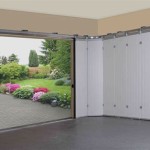The Perfect Size For Your Single Car Garage Doors
Selecting the correct size for a single-car garage door is a crucial step in ensuring functionality, security, and aesthetic appeal. The appropriate dimensions not only facilitate the easy entry and exit of vehicles but also contribute to the overall look and structural integrity of the garage. This article provides a comprehensive overview of the factors to consider when determining the ideal size for a single-car garage door, covering standard dimensions, influencing factors, and critical measurement considerations.
Understanding the standard sizes available is the foundation of making an informed decision. Deviating from these standards might introduce complications and increase costs. However, adhering to them ensures readily available replacement parts and compatibility with standard garage door openers and accessories.
Standard Single Car Garage Door Dimensions
The most common size for a single-car garage door is 8 feet wide by 7 feet high (8' x 7'). This dimension accommodates most standard passenger vehicles comfortably. It allows sufficient clearance for entry and exit without requiring excessive maneuvering. However, this is not the only available option. Other common sizes include 9 feet wide by 7 feet high (9' x 7') and 10 feet wide by 7 feet high (10' x 7'). The increased width allows for greater ease of access, particularly for larger vehicles or when additional space is needed for storage along the sides of the garage.
While 7 feet tall is generally standard, some garages, especially those designed for trucks or SUVs, may require a taller door. In these cases, 8 feet high (8') is a frequently used alternative. Rarely, a 6'6" height might be encountered in older constructions, but these are increasingly uncommon for modern builds due to the increasing average vehicle height.
The depth of the garage, although not directly related to the door size, is still a critical factor. A garage that is too shallow will negate the benefits of a properly sized door, making parking and maneuvering difficult. A standard single-car garage should ideally be at least 20 feet deep to comfortably accommodate a vehicle and provide space for walking around it.
In summary, while 8' x 7' is the most ubiquitous standard size, the specific needs of the homeowner, including vehicle size and storage requirements, dictate the most appropriate dimensions. It's crucial to consider these factors thoughtfully before making a final decision.
Factors Influencing Garage Door Size Selection
Numerous factors influence the appropriate size for a single-car garage door. These range from the dimensions of the vehicle(s) intended to be housed in the garage to the specific architectural style of the house and local building codes.
Vehicle Size: The primary determinant of the garage door size is the size of the vehicle. A compact car will require less clearance than a large truck or SUV. Consider the height, width, and length of the vehicle. Pay particular attention to the height of any aftermarket additions like roof racks or antennas, as these can significantly impact the required door height. Additionally, factor in any future vehicle upgrades. Designing for a slightly larger door than immediately necessary can prevent the need for costly modifications later on.
Storage Needs: Many homeowners utilize their garages for storage in addition to parking vehicles. If storage shelves or cabinets are planned along the sides of the garage, a wider door is recommended. This provides ample room to maneuver around the vehicle and access stored items without constantly bumping into the sides. Consider the type and amount of storage anticipated when determining the optimal width. Overhead storage also requires consideration, especially if it hangs down lower than the top of a tall vehicle.
Architectural Style: The architectural style of the house can influence the aesthetic considerations of the garage door size. A modern home with clean lines might benefit from a wider, more minimalist garage door, while a traditional home might look better with a standard-sized door. The proportionality of the garage door to the overall facade of the house is crucial for maintaining visual harmony. Consider how the garage door will look in relation to the windows, doors, and other architectural features of the home.
Building Codes and HOA Regulations: Local building codes and homeowner association (HOA) regulations can dictate specific requirements for garage door sizes. These regulations might stipulate minimum or maximum dimensions, material restrictions, or even stylistic guidelines. Always consult with the local building department and HOA before making any decisions regarding garage door size. Failure to comply with these regulations can result in costly fines or delays in the installation process.
Ease of Use and Accessibility: The size of the door also affects the ease of use and accessibility of the garage. A wider door provides more room for error when entering and exiting the garage, reducing the risk of accidental damage to the vehicle or the garage door itself. This is especially beneficial for drivers with limited mobility or those who frequently have passengers exiting the vehicle within the garage. Furthermore, a taller door can make accessing the garage easier for taller individuals, preventing the need to hunch over when entering or exiting.
Future-Proofing: Anticipating future needs is a wise approach. If there's a likelihood of acquiring a larger vehicle or increasing storage needs in the future, selecting a slightly larger garage door upfront can save significant time and expense down the line. This forward-thinking approach ensures that the garage remains functional and adaptable to changing lifestyle requirements.
Critical Measurement Considerations
Accurate measurements are paramount when determining the appropriate size for a single-car garage door. Incorrect measurements can lead to costly mistakes and installation problems. Paying close attention to the following measurement considerations ensures a smooth and successful installation process.
Measure the Rough Opening: The rough opening is the framed opening in the garage wall where the garage door will be installed. This is the critical measurement upon which all other calculations are based. Measure the width and height of the rough opening carefully, taking multiple measurements at different points to ensure accuracy. Note any inconsistencies or variations in the measurements, as these might indicate structural issues that need to be addressed. The garage door will typically be slightly smaller than the rough opening to allow for proper installation and operation.
Check for Obstructions: Before finalizing the garage door size, thoroughly inspect the area for any potential obstructions. These can include pipes, electrical wiring, or ductwork that might interfere with the installation or operation of the door. Take precise measurements of the location and dimensions of any obstructions to determine if they will affect the chosen door size. Consider relocating or modifying these obstructions if necessary to accommodate the desired garage door dimensions.
Account for Headroom and Sideroom: Headroom refers to the space between the top of the garage door opening and the ceiling. Sideroom refers to the space between the sides of the garage door opening and the adjacent walls. Sufficient headroom and sideroom are necessary for the proper installation and operation of the garage door tracks and hardware. Consult the manufacturer's specifications for the minimum required headroom and sideroom for the chosen garage door model. Ensure that there is adequate space available before finalizing the door size. Low headroom situations may necessitate specialized hardware or door designs.
Consider the Garage Door Opener: The type of garage door opener being used can also influence the required headroom. Some openers require more headroom than others. Review the specifications of the chosen opener and ensure that there is sufficient space available for its installation. Consider a low-headroom opener if space is limited. Integrating the garage door opener requirements into the initial size considerations helps prevent compatibility issues and ensures seamless operation.
Level the Floor: An uneven garage floor can affect the proper operation of the garage door. Inspect the floor for any significant slopes or irregularities. Level the floor if necessary before installing the garage door. This can be done by applying a self-leveling concrete compound. A level floor ensures that the garage door seals properly against the floor, preventing drafts and providing a secure barrier against the elements.
Professional Measurement and Consultation: While homeowners can take preliminary measurements, it is highly recommended to consult with a professional garage door installer. A professional can accurately assess the existing conditions, identify potential challenges, and provide expert guidance on the optimal garage door size for the specific needs and constraints. Their experience and expertise can prevent costly mistakes and ensure a smooth and successful installation.
Ultimately, determining the perfect garage door size entails considering vehicle dimensions, storage needs, architectural considerations, local regulations, and precise measurements. While standard sizes offer a starting point, tailoring the dimensions to the specific circumstances is essential for optimal functionality, aesthetics, and long-term satisfaction.

What Are The Standard Garage Door Sizes Home Depot

Residential Garage Doors Available Sizes Garaga

One Car Garage Sizes A Guide To Standard Dimensions

Garage Door Dimensions Detailed Wessex Doors

Residential Garage Doors Available Sizes Garaga

What Are The Standard Garage Door Sizes Home Depot

The Ultimate Guide To Garage Dimensions Choosing Right Size For Your

What Are The Standard Garage Door Sizes Home Depot

One Car Garage Sizes A Guide To Standard Dimensions

Average Garage Size Choosing The Right Sized For Your Needs Hws Garages
Related Posts








